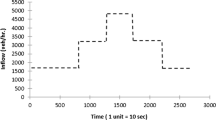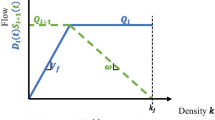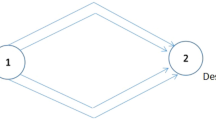Abstract
With the development of traffic flow theory and practice, traffic models at different levels of analysis are expected to provide comprehensive outputs with satisfactory efficiency. Accordingly, this research proposes an Equivalent Link traffic State Model (ELSM) to meet this requirement. ELSM combines both advantages of Vertical Queue Model (VQ) and Horizontal Queue Model (HQ). On one hand, the structure of ELSM is similar to VQ; on the other hand, queue dynamics at any moment along the link can be available through deriving three “characteristic points” of each cycle based on shock wave theory. Thus spatial variation of vehicle queue can be obtained. As a result, common traffic performance indexes such as delay, stops and queue length can be directly obtained in addition to the microscopic level variables such as vehicle trajectories and travel time. It is shown that with the increasing of numerical resolution, the results of CTM (Cell Transmission Model) gradually converge to ELSM.
Similar content being viewed by others
References
Aboudolas, K., Papageorgiou, M., Kouvelas, A., and Kosmatopoulos, E. (2010). “A rolling-horizon quadratic-programming approach to the signal control problem in large-scale congested urban road networks.” Transportation Research Part C: Emerging Technologies, Vol. 18, No. 5, pp. 680–694.
Awasthi, A., Lechevallier, Y., Parent, M., and Proth, J.-M. (2005). “Rule based prediction of fastest paths on urban networks.” 2005 IEEE Intelligent Transportation Systems Conference (ITSC), pp. 978–983.
Ban, X., Pang, J. S., Liu, H. X., and Ma, R. (2012). “Continuous-time point-queue models in dynamic network loading.” Transportation Research Part B: Methodological, Vol. 46, No. 3, pp. 360–380.
Chiabaut, N., Buisson, C., and Leclercq, L. (2009). “Fundamental diagram estimation through passing rate measurements in congestion.” Ieee Transactions on Intelligent Transportation Systems, Vol. 10, No. 2, pp. 355–359.
Chow, A. H. F. and Lo, H. K. (2007). “Sensitivity analysis of signal control with physical queuing: Delay derivatives and an application.” Transportation Research Part B: Methodological, Vol. 41, No. 4, pp. 462–477.
Daganzo, C. F. (1994). “The cell-transmission model: A dynamic representation of highway traffic consistent with the hydrodynamic theory.” Transportation Research PartB, Vol. 28, No. 4, pp. 269–288.
Daganzo, C. F. (1995). “The cell transmission model, part II-Network traffic.” Transportation Research Part B, Vol. 29, No. 2, pp. 79–93.
Daganzo, C. F. (2007). “Urban gridlock: Macroscopic modeling and mitigation approaches.” Transportation Research Part B: Methodological, Vol. 41, No. 1, pp. 49–62.
Geroliminis, N. and Daganzo, C. F. (2008). “Existence of urban-scale macroscopic fundamental diagrams: Some experimental findings.” Transportation Research Part B: Methodological, Vol. 42, No. 9, pp. 759–770.
Helbing, D. (2003). “A section-based queueing-theoretical traffic model for congestion and travel time analysis in networks.” Journal of Physics A: Mathematical and General, Vol. 36, No. 46, pp. L593–L598.
Lawson, T. W., Lovell, D. J., and Daganzo, C. F. (1997). “Using the input-output diagram to determine the spatial and temporal extents of a queue upstream of a bottleneck.” Transportation Research Record, Vol. 1572, pp. 140–147.
Lighthill, M. J. and Whitham, G. B. (1955). “On kinematic waves II. A theory of traffic flow on long crowded roads.” Proc. of the Royal Soc., A Vol. 229, No. 1178, pp. 317–345.
Liu, Y. and Chang, G.-L. (2010). “An arterial signal optimization model for intersections experiencing queue spillback and lane blockage.” Transportation Research Part C: Emerging Technologies, Vol. 19, No. 1, pp. 130–144.
Michalopoulos, P. G., Beskos, D. E., and Lin, J. K. (1984). “Analysis of interrupted traffic flow by finite difference methods.” Transportation Research Part B: Methodological, Vol. 18, Nos. 4–5, pp. 409–421.
Newell, G. F. (1993). “A simplified theory of kinematic waves in highway traffic, I general theory, II queuing at freeway bottlenecks, III multi-destination flows.” Transportation Research Part B: Methodological, Vol. 27, No. 4, pp. 281–313.
Newell, G. F. (1993). “A simplified theory of kinematic waves in highway traffic, Part I: General theory.” Transportation Research Part B: Methodological, Vol. 27B, No. 4, pp. 281–287.
Ng, M. and Waller, S. T. (2012). “A dynamic route choice model considering uncertain capacities.” Computer-Aided Civil and Infrastructure Engineering, Vol. 27, No. 4, pp. 231–243.
Ran, B., Rouphail, N. M., Tarko, A., and Boyce, D. E. (1997). “Toward a class of link travel time functions for dynamic assignment models on signalized networks.” Transportation Research Part B: Methodological, Vol. 31, No. 4, pp. 277–290.
Richards, P. I. (1956). “Shocks waves on the highway.” Oper. Res., Vol. 4, pp. 42–51.
Stevanovic, A., Stevanovic, J., Zhang, K. and Batterman, S. (2009). “Optimizing traffic control to reduce fuel consumption and vehicular emissions.” Transportation Research Record: Journal of the Transportation Research Board, Vol. 2128, pp. 105–113.
Wu, X. and Liu, H. X. (2011). “A shockwave profile model for traffic flow on congested urban arterials.” Transportation Research Part B: Methodological, Vol. 45, No. 10, pp. 1768–1786.
Author information
Authors and Affiliations
Corresponding author
Rights and permissions
About this article
Cite this article
Qi, H., Wang, D., Chen, P. et al. A link traffic model by incorporating both merits of vertical and Horizontal Queue Concept. KSCE J Civ Eng 17, 1117–1129 (2013). https://doi.org/10.1007/s12205-013-0141-3
Received:
Revised:
Accepted:
Published:
Issue Date:
DOI: https://doi.org/10.1007/s12205-013-0141-3




